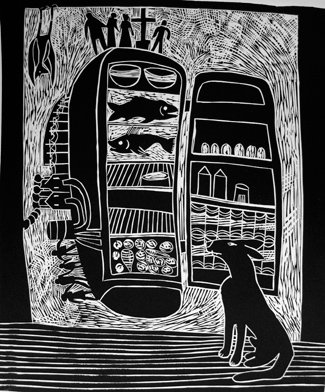Art fair showcases indigenous work

FOR JUDY WATSON, going back to Riversleigh Station in North West Queensland where her grandmother was born is a way of reconnecting with country, ancestral identity and the memories that drive her as an artist.
Judy’s acclaimed prints, installations and paintings often mix Aboriginal history with elements of her family’s past, government documents and everyday objects to provide a glimpse of how Aboriginal people lived and were perceived in the first half of the 20th century.
“I’m trying to see the country through the eyes of my grandmother,” she says, “trying to understand what it was like for Aboriginal people and Aboriginal women in particular.”
Judy is a Brisbane-based Waanyi woman, one of the 250-odd Queensland artists whose work will be showcased at this year’s Cairns Indigenous Art Fair (CIAF). From 19-21 August, artists from communities in the Torres Strait and across Far North Queensland will descend on Cairns to exhibit, sell and talk about their creations.
Judy hopes initiatives like CIAF will promote Queensland’s Indigenous artists to buyers and put money back into communities.
“For a long time Queensland Aboriginal art was seen as tourist art. People were very ignorant of what artists in those regions were doing,” she says. “Artists just want to work, and to be paid as an artist is brilliant.”
Aboriginal history underlies Australian modern society
At CAIF Judy is presenting Names of the Natives, part of a collaborative project she was involved in at Blue Mud Bay, Arnhem Land.
In 2008, Blue Mud Bay became the centre of a Supreme Court battle when the Northern Territory Government started approving licenses for commercial fishing in the area. Eventually, the indigenous owners were able to prove their deep knowledge of the land to win back control over their coast.
Judy’s etching incorporates fragments from the history of the area – sea shells, Kurrajong trees, earthy colours and extracts from the historical texts used in the court case.
“I’m always interested in the Aboriginal history because that underlies everything, whether there’s a city on top or not, there’s still that first layer.”
She says community art projects, like the one in Arnhem Land, should also be organised in Queensland to raise the profile of artists in remote parts of the state.
Torres Strait Islander art hung in New York and Paris
Alick Tipoti, a Torres Strait Islander, is also showcasing his art in Cairns. Alick hails from Badu Island and has been interested in art since he was a kid. He speaks his native language, Kala Lagaw Ya of the Maluilgal nation of Zenadh Kes and spent many years studying artefacts from the Torres Strait and the Pacific.
“I’ve spent a lot of time with elders and I’m blessed to have that knowledge,” he says.
Alick is well known for his detailed lino designs, which have been hung in galleries from New York to Paris. But for this year’s art fair he is taking a different tack. Instead of lino, he will be exhibiting 20 fibreglass masks.
“I’m really excited about it. It’s going to launch my new medium,” he says. “Although there will still be one lino of 8.2 metres, I couldn’t leave the lino out altogether.”
He has already taken seven of the feather and bead-adorned masks back to Badu Island.
“I wanted to give something back to the community,” he says. “I got the blessing, and they even said my masks brought back memories of the old masks they used to make there.”

Artist: Dennis Nona Saulal (Courtesy the artist and the Australian Art Network, Cairns and Sydney)
Boost for Indigenous Artists
The CIAF, now in its third year, is visited by thousands of people from around Australia and the world. Artistic Director Avril Quaill says she is thrilled to showcase the work of emerging artists alongside leading Indigenous names.
“What we’re seeing is that inspiration if you like, with emerging artists from here mixing and being able to share stories and get ideas and tips from the established Queensland indigenous artists,” she says.
Besides the exhibition, CAIF will also feature dancing, music, film screenings, markets and workshops to promote Aboriginal and Torres Strait Islander cultures. The art fair is part of the Queensland Government’s $11.93 million Backing Indigenous Arts program, which aims to support Indigenous artists in Far North Queensland build sustainable careers and sell their work.
Over the past two years CIAF has sold more than $1.2 million in art. For more information or to buy tickets, visit www.ciaf.com.au.
RELATED STORIES

